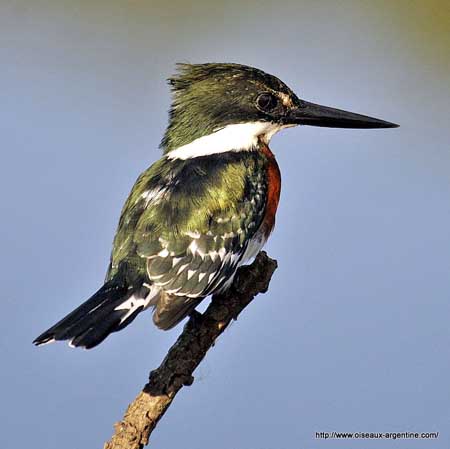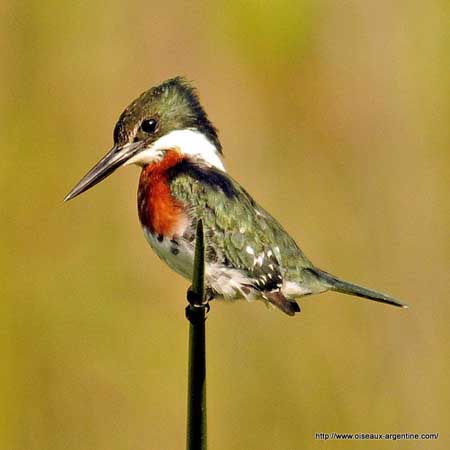
Fr: Martin-pêcheur vert
All : Grünfischer
Esp : Martín Pescador Verde
Ital : Martin pescatore verde
Nd: Groene Ijsvogel
Sd: Grön kungsfiskare
Port: Martim-pescador-pequeno
Photographers:
Philippe et Aline Wolfer
GALERIE
Text by Nicole Bouglouan
Sources:
HANDBOOK OF THE BIRDS OF THE WORLD Vol 6 by Josep del Hoyo-Andrew Elliott-Jordi Sargatal - Lynx Edicions, 2001 - ISBN: 848733430X
A GUIDE TO THE BIRDS OF COLOMBIA by Steven L. Hilty and William L. Brown - Princeton University Press – ISBN 069108372X
A GUIDE TO THE BIRDS OF MEXICO AND NORTHERN CENTRAL AMERICA by Steve N. G. Howell, Sophie Webb - Oxford University Press - ISBN: 0198540124
BirdLife International (BirdLife International)
SORA Searchable Ornithological Research Archive (Blair O. Wolf)
What Bird-The ultimate Bird Guide (Mitchell Waite)
XENO-CANTO – Sharing Birds sounds from around the world
Green Kingfisher
Chloroceryle americana
Coraciiforme Order – Alcedinidae Family
BIOMETRICS:
Length: 20 cm
Wingspan: 28-33 cm
Weight: 40-55 g
DESCRIPTION:
The Green Kingfisher is smaller than other kingfishers, and lacks the usual blue-grey plumage coloration.
The adult male has dark green upperparts with glossy bronze crown. The upperwing shows numerous white spots on primaries, secondaries and wing-coverts. These spots form several lines across the wing. On the tail, the rectrices show white spots on the inner webs. We can see larger white areas at the base of the outermost rectrices.
A conspicuous white collar separates the head from the body.
On the underparts, chin and throat are white, whereas the breast is bright rufous. The belly is white, with blackish green bars on body sides, flanks and undertail-coverts.
The large dagger-like bill is black, with yellowish lower mandible base. The lores are black and the eyes are dark brown. Legs and feet are grey.

The adult female resembles male but she lacks the bright rufous coloration. She has creamy-white throat and lower breast, and glossy bronze-green upper breast and upper belly with white-tipped feathers, forming two dark green mottled breast bands with the lower one often incomplete.
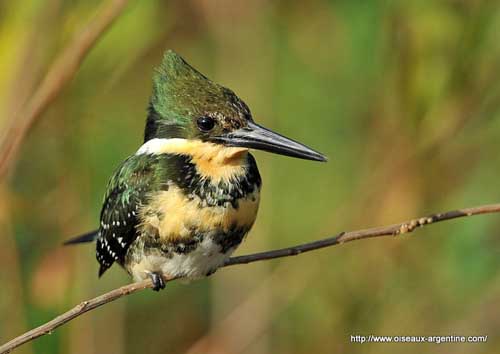
The juvenile is similar to the female but duller, with buff spots on crown and wing-coverts.
We can find five subspecies which differ in body and bill size, in plumage tone and in white spotting extent and pattern.
VOICE: SOUNDS BY XENO-CANTO
The Green Kingfisher gives hard dry clicking notes “tick tick tick”, and also dry rasping followed by buzzy “sree-ssee-ssee-ee srri-srri-srri”.
When alarmed, it utters a twittering rattle, and we can also hear creaking scratchy notes.
The fly call is a low, pebbly “choot” often repeated 2-3 times.
HABITAT:
The Green Kingfisher frequents a wide variety of waters such as woodland streams, rocky watercourses, deep rivers, forest pools, flooded woodland, marshes, lakes, coastal lagoons, mangroves and coastal waters.
It usually prefers open habitats, and can be seen from sea-level to 2800 metres of elevation in Mexico. But it is usually commoner below 1000 metres.
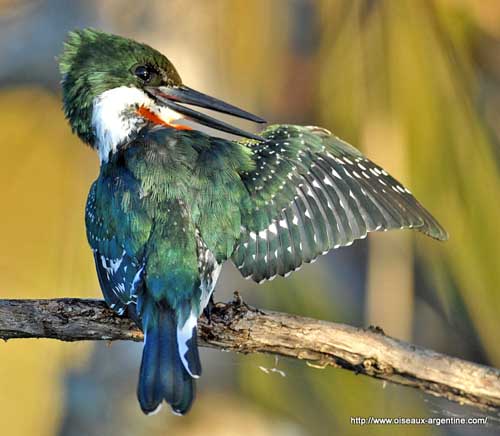
RANGE:
The Green Kingfisher has wide range from southern Texas, through Central America and South America to C Argentina.
This species is sedentary in its range.
BEHAVIOUR:
The Green Kingfisher feeds on aquatic preys such as small fish, crustaceans, prawns, and it also takes insects.
As other kingfishers, it perches on rock, fence or branch along the water, waiting for prey. It may sometimes bob the head and flick the tail before to dive steeply into the water. Then, it returns to its perch with the prey.
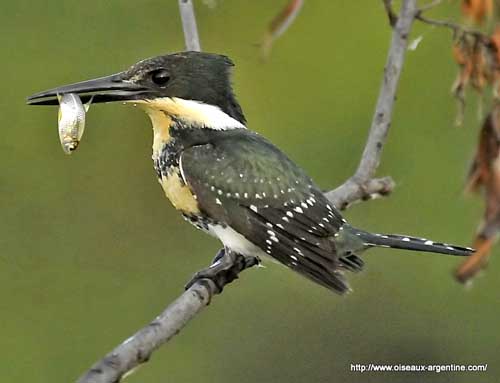
It may also hover about 4-6 metres above the surface, while scanning for fish. We can see sometimes several individuals on scattered perches near cover along river banks or lake edges, watching for preys.
But during the winter, it tends to be solitary. It forages during the day, and probably roosts at night in trees or bushes within the territory.
Usually, this species is highly territorial and often defends the breeding area, but also the feeding territory, by flying attacks or aerial chases.
In spring, the Green Kingfisher becomes less solitary and the calls are increasing. It fights for territory if other males are in the surroundings. When excited, it bobs the body and flicks the tail up and down.
The courtship displays are poorly known, but the male probably performs courtship feeding to the female, some chases around the potential nest-site, and adopts several postures to expose the bright rufous breast band in front of the female. The male may perform aerial displays and gives advertising calls.

FLIGHT:
The Green Kingfisher has direct, fast flight usually performed fairly low close to the water.
REPRODUCTION:
The breeding season varies according to the range.
As numerous Alcedinidae species, the Green Kingfisher’s nest is placed in earth bank near forest streams or in mangroves. Both sexes excavate the tunnel of 4-6 cm wide and 40-100 cm long. An unlined nest-chamber is at the end of the inclined tunnel. The entrance is usually hidden by the overhanging vegetation, and placed at about 1-3 metres above the water-level.

The female lays 4-5 white eggs. The incubation lasts three weeks during which the female incubates at night and the male during the day. The chicks are fed by both parents, and fledge about 27 days after hatching; they still depend on adults for 4 weeks after leaving the nest.
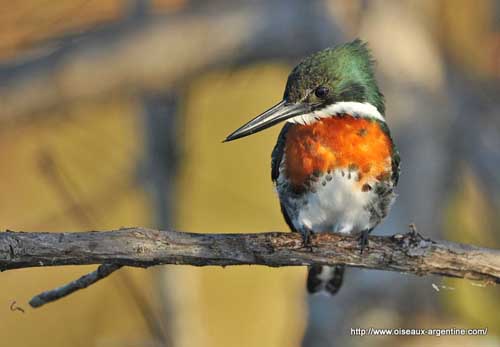
DIET:
The Green Kingfisher feeds primarily on aquatic preys such as small fish (Characidae), crustaceans and prawns. If the fish is scarce, it also catches aquatic insects and dragonfly nymphs (Odonata), Hemiptera and Hymenoptera. Small lizards and grasshoppers may be occasionally taken.
PROTECTION / THREATS / STATUS:
The Green Kingfisher is widespread in most parts of the range, and frequently common.
This species is not currently threatened.
